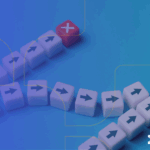
Most organizations begin their experimentation journey with genuine enthusiasm.
Leadership champions the data-driven approach, teams eagerly embrace A/B testing, and early wins create momentum that spreads throughout the organization. Yet recent research reveals a sobering reality: only 12% of organizations rate their experimentation strategy and culture as truly transformative.
The gap between initial excitement and sustained capability represents one of the most significant challenges facing modern organizations. While the industry celebrates velocity metrics and tool adoption, the real value lies in building institutional capability that transforms how organizations make decisions.
The Inevitable Plateau
The experimentation journey typically follows a predictable arc. Organizations start with high energy and clear wins, often achieving 20-30% improvement rates in their first wave of tests. Marketing teams optimize conversion funnels, product teams improve user experiences, and leadership celebrates the power of data-driven decision making.
However, this initial success often masks fundamental structural problems that emerge as programs scale. Teams begin running duplicate experiments across departments. Insights remain trapped in individual projects rather than becoming organizational knowledge. Most critically, the connection between experimental results and actual business outcomes begins to weaken.
This phenomenon, known as the “Trust Gap,” manifests when promising test results fail to translate into expected business outcomes when implemented at scale. Research shows that 42% of experiment implementations fail to deliver their predicted impact, creating a cycle of diminishing confidence in the experimentation program itself.
The Governance Challenge
The root cause of this plateau is not execution but lack of governance.
Organizations excel at running individual experiments but struggle to build systematic capability that ensures testing improves their most important business decisions.
Traditional approaches focus on democratizing access to testing tools, training more people in statistical methods, and increasing test velocity. While these tactical improvements have merit, they address symptoms rather than causes. The fundamental challenge is creating institutional frameworks that connect experimentation to strategic decision-making.
Consider the difference between having better tools and building better capabilities. Tools help teams run experiments faster, but governance ensures those experiments actually improve business outcomes. Platforms enable self-service testing, but governance creates organizational learning that persists across personnel changes and restructuring.
The Complete Learning Loop
Sustainable experimentation capability requires implementing what we call the Complete Learning Loop, a systematic approach that ensures experiments contribute to institutional knowledge rather than remaining isolated activities.
Strategic Direction
The loop begins with strategic alignment. Every experiment should connect to specific business objectives, not just team-level optimization goals. This requires frameworks that translate corporate strategy into testable hypotheses and ensure experimental work supports broader organizational priorities.
Governed Experimentation
The testing phase itself requires governance structures that balance methodological rigor with innovation speed. This means establishing quality standards without creating bureaucratic friction, ensuring statistical validity while maintaining team autonomy, and creating consistent documentation practices that enable knowledge transfer.
Reliable Insights
The analysis phase must generate insights that leadership can trust and act upon. This requires not just statistical significance but business significance, connecting test results to meaningful business outcomes and providing confidence intervals that inform decision-making.
Systematic Implementation
Perhaps the most critical and overlooked stage is ensuring insights become actions. Organizations need structured processes for translating experimental results into business changes, tracking implementation fidelity, and measuring real-world impact against predicted outcomes.
Organizational Learning
The final stage captures insights as institutional knowledge that informs future decisions. This requires systems for preserving learnings across team changes, surfacing relevant past insights when new decisions arise, and building cumulative intelligence that improves strategic thinking over time.
Executive Confidence: The Ultimate Measure
The most reliable indicator of experimentation maturity is not test volume or statistical sophistication but executive confidence in acting on experimental results. Mature programs create leadership dashboards that show how experiments influence business outcomes, not just activity metrics.
This confidence emerges from governance frameworks that provide visibility into program effectiveness, accountability for implementation outcomes, and systematic approaches for connecting experimentation to business objectives. When executives can trust that experimental insights will translate into reliable business results, experimentation becomes a strategic capability rather than a tactical activity.
Building Institutional Capability
The transition from initial excitement to sustainable capability requires deliberate investment in governance infrastructure. This means moving beyond the tactical question of “How do we run more tests?” to the strategic question of “How do we ensure experimentation improves our most important business decisions?”
Framework Development
Organizations need structured approaches for connecting experiments to strategic objectives, ensuring methodological quality, and translating insights into business actions. These frameworks should be comprehensive enough to ensure consistency while flexible enough to support innovation.
Knowledge Management
Insights must become institutional intelligence that survives personnel changes and organizational restructuring. This requires systems for capturing learnings, surfacing relevant past insights, and building cumulative knowledge that improves decision-making over time.
Cross-Functional Integration
Experimentation cannot remain siloed within individual teams. Mature programs create systematic approaches for sharing insights across departments, preventing contradictory experiments, and connecting tactical learnings to strategic implications.
Measurement Systems
Success metrics must evolve from activity-based measures to outcome-based measures. Rather than tracking tests run or features shipped, mature programs measure decision quality, implementation success rates, and business impact attribution.
The Path Forward
Organizations serious about experimentation as a strategic capability must recognize that the goal is not to run more experiments but to make better decisions. This requires governance, not just democratization. It requires institutional capability, not just individual expertise.
The good news is that building this capability does not require armies of data scientists or sophisticated engineering infrastructure. It requires systematic approaches that connect testing to decision-making, measurement frameworks that track decision quality rather than just activity, and organizational structures that preserve and leverage institutional learning.
The transition from excitement to excellence is not automatic. It requires deliberate investment in governance frameworks that ensure experimentation delivers on its promise of improving business outcomes. Organizations that make this investment will find that experimentation becomes not just a tool for optimization but a sustainable competitive advantage.
Conclusion
The experimentation industry has been remarkably effective at promoting solutions that benefit vendors and consultants rather than the organizations they serve. True experimentation maturity is not about copying successful companies or following democratization playbooks. It is about building institutional capabilities that systematically improve decision quality across the organization.
This requires moving beyond the tactical to the strategic, beyond individual experiments to organizational learning, and beyond activity metrics to business impact. The organizations that build these capabilities will not be the loudest voices in the industry. They will be too busy using experimentation to build sustainable competitive advantages.
The journey from initial excitement to institutional excellence is challenging but achievable. It requires commitment to governance over volume, strategic thinking over tactical execution, and institutional capability over individual expertise. For organizations willing to make this investment, experimentation becomes not just a practice but a fundamental capability that transforms how they compete and win in their markets.




